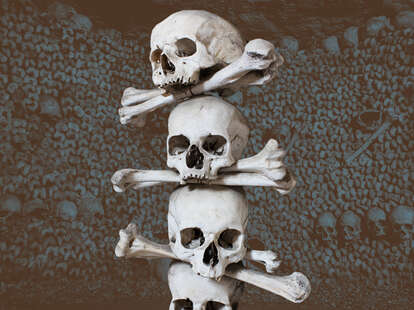Dancing skeletons, talking skulls, and all those other Halloween images, and well just couldn't resist posting this.
What Do Catacombs Really Smell Like?
We asked an archaeologist if the smell is "deadly" at all.

Synesthesia is the sensory crossover that allows certain people to mentally "smell colors" or "taste words" or decide that Thursday is brown.
It just so follows that to a regular synesthetic mind the month of October is likely characterized by a strong scent of pumpkin spice. Not mine, though. To my brain, October is dead leaves and stale books, the reasoning being that if the presence of dead things largely defines it, that's probably the scent it emanates.
But not everything is what it seems. Take catacombs, for example. The ancient underground burial sites filled to the brim with human bones must reek with a nose-curling stench of death. Or do they?
Personally, I haven't visited any of the world's most famous catacombs yet. So I asked someone who would know—an archaeologist—to tell me what I should expect to smell upon descending into one of these old and ominous ossuaries.
What do catacombs smell like?
Horror travel enthusiasts give all sorts of answers. Some TripAdvisor reviewers of the Paris Catacombs compared their smell to a dusky old library, while other travelers who visited other catacombs noted a faint scent of incense. None of them claimed what I expected—that they stink to heaven.
When I asked Dr. Rachel Kalisher, who holds a PhD in archaeology from Brown University and is a visiting clinical assistant professor of anthropology at New York University, if this was accurate, she agreed.
"The idea that there's the smell of death is primarily connected to decomposing bodies or rotting flesh or putrefaction or any of the kinds of smells that are associated with the liquidation of soft tissue," Kalisher explained. "And we don't have that in this case."
Throughout the years, catacombs have been both a primary burial site and a secondary one. In a primary burial site, corpses are both buried and left to decompose. A secondary burial site, instead, carries only the bones of the bodies that were left to fully decompose in another location beforehand. Some of the most iconic catacombs in the world, like the Paris ones, are usually secondary burial sites, meaning they could never smell like rotting flesh.
"That's not only because so much time has passed," Kalisher said. "But because what you're dealing with is a bunch of people who already decomposed in a grave somewhere and then were exhumed. There's really no adhering soft tissue whatsoever. There's no traces of it."
Bones themselves, while tough to break down and resistant in nature (they contain many minerals), don't really smell. Since no tissue is attached to them, they are no different from, say, a rawhide chew toy.
As a whole, catacombs likely smell like your basement. "All we're really smelling when you go into one of these really enclosed spaces is what you would smell in any other damp or slightly humid, dark space where there's perhaps not a lot of air circulation," Kalisher explained.
Now that we've cleared the air about their smell, you can relax about the next question you might be wondering. Is it safe to breathe the air of catacombs, considering they're full of human remains?
The answer is yes; you have nothing to worry about. As long as you don't try and chew down on a bone, you should be safe from any pathogens.
"There's no active harm in breathing the air," Kalisher said. "Pathogens aren't living that long because there is biologically no way for them to survive. They need hosts in order to live, so if the body's dead, they are not going to survive."
As it turns out, the air in the catacombs might not be a hazard. But Kalisher will tell you that the humans visiting the sites actually might be. "The modern living people that are walking around the catacombs are the more active agents of decomposition and taphonomy now for the bones than the bones themselves!" Kalisher explained.
